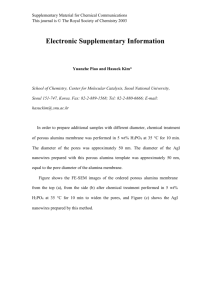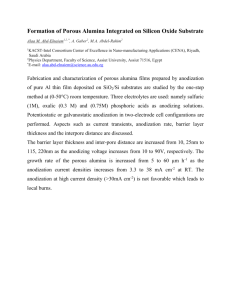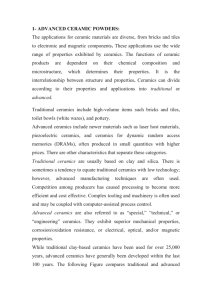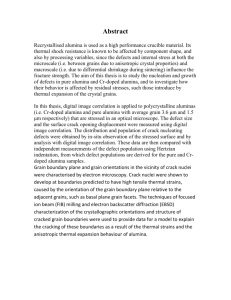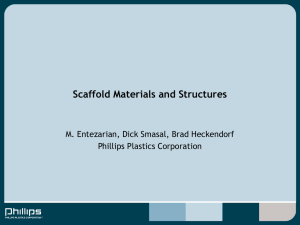1301619
advertisement
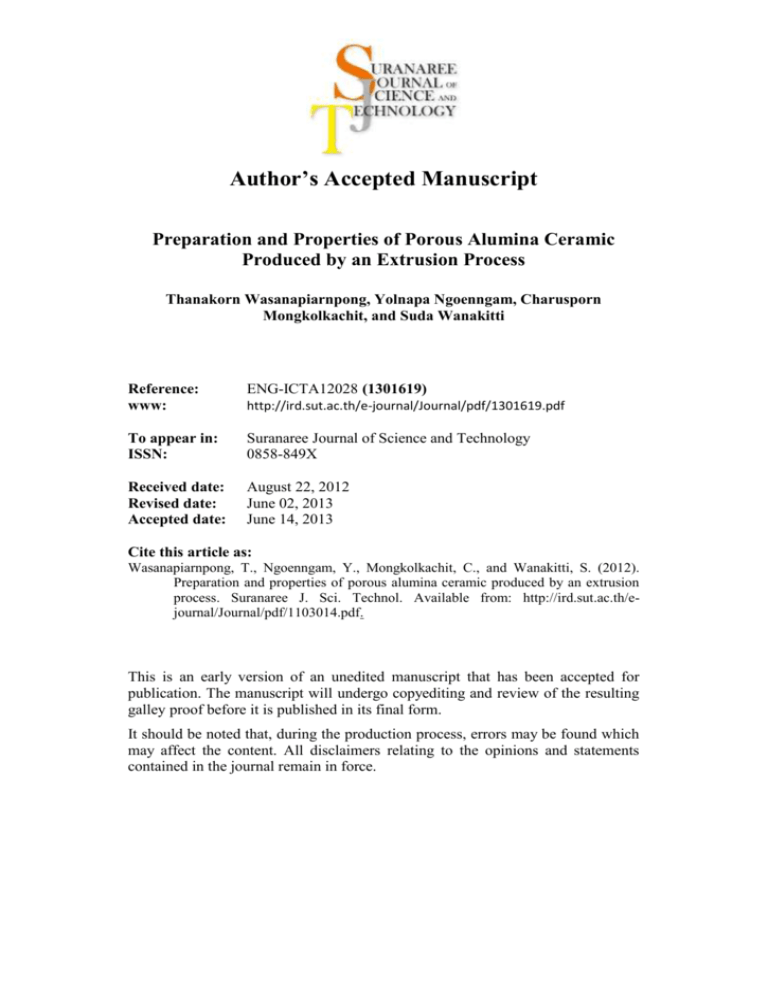
ACCEPTED MANUSCRIPT Author’s Accepted Manuscript Preparation and Properties of Porous Alumina Ceramic Produced by an Extrusion Process Thanakorn Wasanapiarnpong, Yolnapa Ngoenngam, Charusporn Mongkolkachit, and Suda Wanakitti Reference: www: ENG-ICTA12028 (1301619) To appear in: ISSN: Suranaree Journal of Science and Technology 0858-849X Received date: Revised date: Accepted date: August 22, 2012 June 02, 2013 June 14, 2013 http://ird.sut.ac.th/e-journal/Journal/pdf/1301619.pdf Cite this article as: Wasanapiarnpong, T., Ngoenngam, Y., Mongkolkachit, C., and Wanakitti, S. (2012). Preparation and properties of porous alumina ceramic produced by an extrusion process. Suranaree J. Sci. Technol. Available from: http://ird.sut.ac.th/ejournal/Journal/pdf/1103014.pdf. This is an early version of an unedited manuscript that has been accepted for publication. The manuscript will undergo copyediting and review of the resulting galley proof before it is published in its final form. It should be noted that, during the production process, errors may be found which may affect the content. All disclaimers relating to the opinions and statements contained in the journal remain in force. 0 ACCEPTED MANUSCRIPT PREPARATION AND PROPERTIES OF POROUS ALUMINA CERAMIC PRODUCED BY AN EXTRUSION PROCESS Thanakorn Wasanapiarnpong1,2*, Yolnapa Ngoenngam1,2, Charusporn Mongkolkachit3, and Suda Wanakitti3 Received: August 22, 2012; Revised: June 02, 2013; Accepted: June 14, 2013 Abstract Porous alumina ceramic was fabricated by an extrusion method with the addition of titania as a sintering additive up to 20 wt%. Alumina powders were mixed and kneaded with titania and organic additives including binder (carboxy methyl cellulose, 7 wt% based on dry weight of alumina and titania; all wt% mentioned in this study based on the amount of inorganic powders excluding water), co-binder (polyvinyl alcohol, 1 wt%), plasticizer (polyethylene glycol, 0.5 wt%), lubricant (glycerin oil, 1 wt%), and solvent (water, 23 wt%). The resulting dough was extruded, dried at room temperature for 48 hours, and sintered at 1,200oC for 1 hour in an electrical box furnace. The phase composition, microstructure, mechanical strength, and porosity of the sintered porous bodies were also investigated. With 5 and 10 wt% of TiO2, the bending strength of the sintered specimens is higher than 18 MPa with porosity of more than 40%. Keywords: Alumina, titania, porous ceramic, extrusion Introduction Porous ceramics are widely used as filters, catalyst carriers, separation membranes, and bio-ceramics. There have been many studies focused on the preparation of porous ceramics. Generally, porous ceramics have good properties such as high mechanical strength, abrasion resistance, and chemical and thermal stability (Isobe et al., 2006). Furthermore, permeability is one of the most important properties of porous ceramics for filters because this property directly 1 Research Unit of Advanced Ceramics, Department of Materials Science, Faculty of Science, Chulalongkorn University, Bangkok, 10330, Thailand. Tel.: 0-2218-5541; Fax.: 0-2218-5561; E-mail: thanakorn.w@chula.ac.th 2 Center of Excellence on Petrochemical and Materials Technology, Chulalongkorn University, Bangkok, 10330, Thailand. 3 National Metal and Materials Technology Center, Klong Luang, Phathumthani, 12120, Thailand. * Corresponding author Suranaree J. Sci. Technol.: ENG-ICTA12028 1 ACCEPTED MANUSCRIPT relates to the pressure drop during filtration (Isobe et al., 2007). Thus, the development of porous ceramics requires sufficient mechanical and chemical stability as well as permeability. The main raw materials of commercial porous ceramics are alumina, zirconia, titania, silica, and mullite (Dong et al., 2006; Jedidi et al., 2009). Alumina is the most widely used of the oxide ceramics because of its hardness, good corrosion resistance, high thermal resistance, and ease of processing (Sathiyakumar and Gnanam, 2003). In order to promote ceramic sintering kinetics or reduce the sintering temperature, there are 2 techniques which may be applied, using superfine powders and using sintering additives (Wang et al., 2007). The additives, such as MgO, TiO2, ZrO2, Y2O3, and La2O3, have an influence on the sinterability, microstructure, and mechanical properties of alumina (Sathiyakumar and Gnanam, 2003). Normally, the solid-state reaction between Al2O3 and TiO2 above the eutectoid temperature 1,280oC can form aluminum titanate. Aluminum titanate in the Al2O3/TiO2 system increases the concentration of vacancies and the transfer rate of mass (Park et al., 2003; Qi et al., 2010). Porous ceramics can be prepared by several methods such as slip casting, centrifugal casting, extrusion, and isostatic pressing. Among these methods, an extrusion process has an advantage in the production of rods, tubes, and honeycombs. In this research, porous alumina ceramics consisting of alumina and titania were prepared by the extrusion method using alumina dough containing organic additives including binders (sodium carboxy methyl cellulose), co-binder (polyvinyl alcohol), plasticizer (polyethylene glycol), lubricant (glycerin oil), and solvent (distilled water). The phase composition, microstructure, mechanical strength, density, porosity, and pore size of the sintered porous bodies were also investigated. Materials and Methods Raw Materials and Sample Preparation Commercially available Al2O3 (AL-05, Hindalco Industries Ltd., Mumbai, India) and TiO2 (R818, China) powders were used as starting raw materials in this work. According to the data from the suppliers, the average particle size of the Al2O3 and TiO2 was 5 μm and 0.3 μm, respectively. 1 wt% of polyvinyl alcohol (PVA) was dissolved in 23 wt% of distilled water (based on dry weight of the alumina and titania) by using a magnetic stirrer at 80oC for 1 h. The alumina powders were first mixed with 0, 5, 10, 15, and 20 wt% of TiO2 powders. Subsequently, the powders were then mixed and kneaded with 7 wt% of sodium carboxy methyl cellulose (CMC), 0.5 wt% of polyethylene glycol (PEG), 1 wt% of glycerin oil, and the solution of polyvinyl alcohol. The binder composition was the same as that used in a previous study (Gosuphan, 2009). The dough was extruded to form the samples with a 10 mm diameter and 120 mm length by the hydraulic extrusion pushing type. The extruded green bodies were dried at room temperature for 48 h and 110oC for 24 h. The dried 2 ACCEPTED MANUSCRIPT samples were then sintered at 1200°C for 1 h in an electrical box furnace with a heating rate of 5°C/min. Five kinds of samples with different compositions are referred as A1 (Al2O3: TiO2 = 100:0), A2 (Al2O3: TiO2 = 95:5), A3 (Al2O3: TiO2 = 90:10), A4 (Al2O3: TiO2 = 85:15), and A5 (Al2O3: TiO2 = 80:20). The flow chart of sample preparation is shown in Figure 1. Characterization The density and porosity of the sintered porous bodies were determined by the Archimedes technique using water as an immersion medium (Isobe et al., 2006). The water absorption of the samples was also measured. The linear shrinkage measurement of the samples before and after sintering was determined by a vernier caliper. The mechanical strength of the sintered samples was measured by a 3-point bending test. The sample with a diameter of 10 mm and length of 120 mm was measured with a span length of 80 mm. The phase compositions were identified using X-ray diffractometry (Bruker-AXS, Cu-Kα radiation (λ = 0.154 nm) Bruker Corp., Billerica, MA, USA,). The microstructure of the sintered bodies was observed using a scanning electron microscope (JSM6480LV, JEOL Ltd., Tokyo, Japan). Results and Discussion Table 1 shows the data of bulk density, linear shrinkage, water absorption, porosity, and 3-point bending strength of the specimens fired at 1,200oC for 1 h. When the amount of titania was increased, the bulk density and linear shrinkage of the samples increased; however, the water absorption decreased. Moreover, the porosity of the samples decreased from 48.63 to 39.94% with increasing the amount of titania from 0 wt% to 20 wt%, respectively. Titania is the sintering aid which increases bulk density and decreases porosity. Thus, doping titania into porous alumina leads to a better sintering behavior (Qi et al., 2010). The strength of the sintered samples tends to increase with increasing the titania addition. With 5, 10, and 15 wt% of TiO2 (A2, A3, and A4), the bending strength of the sintered specimens is higher than 18 MPa with porosity of more than 40%. The maximum strength of 23.73 MPa is obtained for A5 (Al2O3: TiO2 = 80:20). The properties of the sintered samples are shown in Table 1. However, the strength of A2-A5 is slightly changed because of the low sintering temperature. Thus, the sintered sample obtained low density. Kritikaki and Tsetsekou (2009) reported that porous alumina ceramic has a mean bending strength of 17 MPa and a porosity of 41%. The porous alumina ceramics were prepared by the extrusion method using pure α-Al2O3 powders with an average particle size of 5 μm and were then sintered at 1500oC. The bending strengths of A2-A5 are higher than that of reported by Kritikaki and Tsetsekou (2009). The phase composition of the porous alumina ceramic A5 (Al2O3: TiO2 = 80:20) sintered at 1200oC is shown in Figure 2. It consists of α-Al2O3 and TiO2 (rutile phase) corresponding to Qi et al., (2010). In their study, the prepared macroporous Al2O3/TiO2 membrane support was sintered at various temperatures. 3 ACCEPTED MANUSCRIPT The phase composition of the support A85/15 (Al2O3/TiO2 = 85/15) sintered at 1200oC consisted of α-Al2O3 and TiO2 (rutile phase). Figure 3 shows the microstructure of the porous alumina ceramics sintered at 1200oC with an addition of 0, 5, 10, 15, and 20 wt% of titania (A1, A2, A3, A4, and A5, respectively). It can be seen that only coarse-grain is Al2O3 in Figure 3a in which the sample is without any addition of titania. The samples with the addition of titania consisted of both coarse-grained Al2O3 and fine-grain TiO2 that are presented in Figure 3(b-e). The fine TiO2 particles gradually appeared more when the amount of titania was increased. These SEM micrographs show that the pores between the grains resulted in the water absorption and open porosity exhibited in Table 1. Conclusions Porous alumina ceramics were prepared by an extrusion method and subsequently sintered at 1200oC for 1 h. The dough for the extrusion was prepared by mixing alumina and small amounts of titania with organic additives. It was shown that the addition of small amounts of titania led to an increase in the bending strength. With the addition of 5, 10, and 15 wt% of TiO2, the bending strength of the sintered specimens was higher than 18 MPa with porosity of more than 40%. The SEM micrographs demonstrated that the pores between grains gave rise to the water absorption of the samples. Acknowledgements The authors would like to thank the Research Unit of Advanced Ceramics, Department of Materials Science, Faculty of Science, Chulalongkorn University, the Center of Excellence on Petrochemical and Materials Technology, Chulalongkorn University, and the partially financed support by the Ratchadaphisek-somphot Endowment Fund and Grants for Development of New Faculty Staff. This work was also supported by National Metal and Materials Technology Center (MTEC) through the project fund MT-B-54-CER-07-275-I and the Thailand Graduate Institute of Science and Technology (TGIST). References Dong, Y., Chen, S., Zhang, X., Yang, J., Liu, X., and Meng, G. (2006). Fabrication and characterization of low cost tubular mineral-based ceramic membranes for microfiltration from natural zeolite. J. Membr. Sci., 281(1-2):592-599. Gosuphan, W. (2009). Fabrication and characterization of cordierite honeycomb ceramic from refractory industrial waste, [MSc. thesis]. Department of Materials Science, Faculty of Science, Chulalongkorn University, Bangkok, Thailand, 75p. 4 ACCEPTED MANUSCRIPT Isobe, T., Kameshima, Y., Nakajima, A., Okada, K., and Hotta, Y. (2006). Extrusion method using nylon 66 fibers for the preparation of porous alumina ceramics with oriented pores. J. Eur. Ceram. Soc., 26(12):2213-2217. Isobe, T., Kameshima, Y., Nakajima, A., Okada, K., and Hotta, Y. (2007). Gas permeability and mechanical properties of porous alumina ceramics with unidirectionally aligned pores. J. Eur. Ceram. Soc., 27(1):53-59. Isobe, T., Tomita, T., Kameshima, Y., Nakajima, A., and Okada, K. (2006). Preparation and properties of porous alumina ceramics with oriented cylindrical pores produced by an extrusion method. J. Eur. Ceram. Soc., 26(6):957-960. Jedidi, I., Saïdi, S., Khmakem, S., Larbot, A., Elloumi-Ammar, N., Fourati, A., Charfi, A., and Ben Amar, R. (2009). New ceramic microfiltration membranes from mineral coal fly ash. Arabian J. Chem., 2(1):31-39. Kritikaki, A. and Tsetsekou, A. (2009). Fabrication of porous alumina ceramics from powder mixtures with sol-gel derived nanometer alumina: Effect of mixing method. J. Eur. Ceram. Soc., 29(9):1603-1611. Park, S.-Y., Jung, S.-W., and Chung, Y.-B. (2003). The effect of starting powder on the microstructure development of alumina–aluminum titanate composites. Ceram. Int., 29(6):707-712. Qi, H., Fan, Y., Xing, W., and Winnubst, L. (2010). Effect of TiO2 doping on the characteristics of macroporous Al2O3/TiO2 membrane supports. J. Eur. Ceram. Soc., 30(6):1317-1325. Sathiyakumar, M. and Gnanam, F. D. (2003). Influence of additives on density, microstructure and mechanical properties of alumina. J. Mater. Process. Technol., 133(3):282-286. Wang, Y., Zhang, Y., Liu, X., and Meng, G. (2007). Sol-coated preparation and characterization of macroporous -Al2O3 membrane support. J. Sol-Gel Sci. Technol.,41(3):267-275. 5 ACCEPTED MANUSCRIPT Table 1. Properties of obtained porous alumina ceramics sintered at 1200°C Bulk Linear Water Open Three-point density shrinkage absorption porosity bending strength (g/cm ) (%) (%) (%) (MPa) SD. A1 1.98 - 24.51 48.63 4.45 3.72 A2 2.16 2.85 20.71 44.83 23.22 2.46 A3 2.25 3.86 18.93 42.57 18.11 2.54 A4 2.28 4.88 18.24 41.56 20.04 3.79 A5 2.32 5.67 17.19 39.94 23.73 3.49 Sample 3 6 ACCEPTED MANUSCRIPT Al2O3 powder 1 wt% PVA + 23 wt% Water + TiO2 (0, 5, 10, 15, 20 wt%) Stirred at 80oC 7 wt % CMC 0.5 wt% PEG 1 wt% Glycerin oil Mixing (knead) Ceramic dough Extruding Hydraulic extrusion Green sample Ø 10 mm x 120 mm Drying Room temperature, 48 h and 110°C, 24 h Firing 1,200°C, 1 h Characterization Figure 1. Flow chart for the preparation of porous alumina ceramics 7 ACCEPTED MANUSCRIPT A = Alpha alumina R = Rutile B = Brookite A A Intensity(a.u.) A A R A A B 20 R R B 30 A A R R 40 R B 50 A RR 60 R R 70 A A 80 2 theta (degree) Figure 2. XRD patterns of porous alumina ceramic A5 (Al2O3: TiO2 = 80:20) sintered at 1,200oC (A; alpha alumina, R; rutile, B; brookite) 8 ACCEPTED MANUSCRIPT (a) (b) (c) (d) (e) Figure 3. SEM micrographs of porous alumina ceramics sintered at 1,200°C; (a) A1 (Al2O3: TiO2 = 100:0), (b) A2 (Al2O3: TiO2 = 95:5), (c) A3 (Al2O3: TiO2 = 90:10), (d) A4 (Al2O3: TiO2 = 85:15), (e) A5 (Al2O3: TiO2 = 80:20) 9
